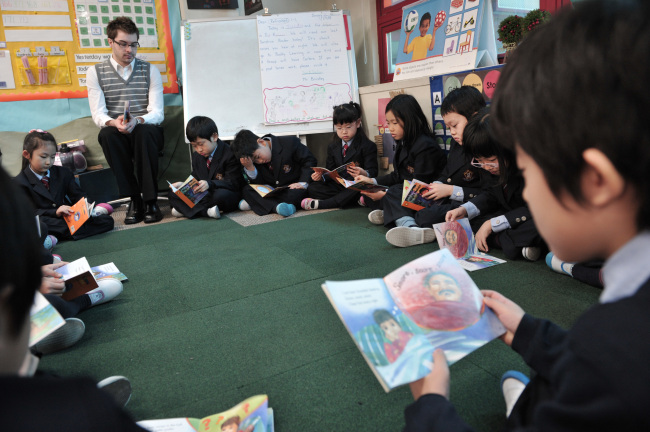South Korea’s English education at public schools has made strides over the last decade with teachers capitalizing on the Internet and other high-tech educational tools to offer more interesting, easier methods to learn the language.
Yet there is still much room for improvement, experts said, citing outmoded evaluation methods, crowded classrooms and insufficient class time allotted for English, to name a few.
Teachers concur that to encourage students to focus more on their communication skills, it is imperative to revamp the evaluation system, as students’ speaking and writing skills are rarely tested.
“It would be fair to say that English education at schools focuses on reading and listening aspects, almost 99 percent (of the time) for sure, because of the college entrance exam testing only the two aspects,” said Kim Jang-won, a teacher of Deok Won Girls’ High School in Seoul.
“Although education authorities here recommend that we teach other aspects of the language, this tends to become only a formality. When the exam only deals with reading and listening, it is difficult to motivate students to spend more time on other parts ― a fundamental obstacle facing public English education.”
 |
Students take an English class at an elementary school in Seoul. (Korea Herald file photo) |
The government had sought to overhaul the evaluation structure by developing the National English Ability Test, and have it evaluate all four aspects of applicants’ language proficiency.
But its introduction was canceled last year amid controversy over its administrative and technical viabilities, and public concerns that the new exam would further increase private education costs.
Apart from the evaluation mechanism, experts also pointed out that there should be more efforts to provide tailored English education to students of widely different proficiency levels.
Most secondary public schools in Korea have divided their English classes into three levels in consideration of students’ language skills. But as the same textbooks and exams are given to all students, teachers have found it difficult to adjust their lessons to meet the specific needs of their students.
“Even if a student is assigned to a low-level class, he or she takes the same exam and uses the same textbook, which may not be suitable for his or her level. So, the student tends to think he or she can’t move up to a higher level and may end up being stuck in the lower level,” said Won Kyu-wang, a teacher at Goyang Global High School in Gyeonggi Province.
“Many may also feel frustrated that they are being compared with one another, all of which could make students lose interest in language acquisition. It is rather a structural problem that we should think about.”
A lack of class time devoted to English and the excessive number of students in each classroom are also cited as areas that need to be improved. Currently, middle- and high-school students study English for about four hours each week. Each class consists of around 30 students.
“When you have 30-35 students in one classroom, it is quite difficult to conduct any speaking classes. Although their reading skills may be similar, their speaking skills vary widely, making it difficult for teachers to devise an effective, optimal way to teach them,” said Kang Dong-heun, a high-school teacher in Incheon.
“On top of that, we have only about four hours each week, and that is too short to expect students to improve their communication skills. But we may not be able to increase the amount of time for English given that there are other subjects they have to learn.”
Recognizing the reality of the classroom restrictions, experts advise that teachers try to find ways to encourage students to make the best use of their classroom time. One way is to promote free interaction among students in English and keep students from just passively taking notes.
“It’s critical that students in the language classroom feel comfortable expressing themselves without repercussions,” said William Packard, an official of Houghton Mifflin Harcourt, an educational publishing firm.
“It’s up to the teacher and fellow students to create a classroom environment where creative thinking and free expression are encouraged. Technology can also help students through this hurdle, providing all students with new ways of interacting in class.”
Above all, exposure to actual spoken English is critical for language acquisition. Each public school used to have one foreign English teacher, but provincial education offices have stopped hiring them due in large part to budgetary constraints.
Observers said that with only one English teacher covering all English speaking classes in a school, it would be difficult to offer quality education to students. Instead, teachers can figure out a better way to increase students’ exposure to English, they said.
“As smartphones and tablet computers become more and more prevalent, there are more opportunities than ever to learn and to practice skills,” said William Packard.
By Song Sang-ho (
sshluck@heraldcorp.com)






![[Herald Interview] 'Trump will use tariffs as first line of defense for American manufacturing'](http://res.heraldm.com/phpwas/restmb_idxmake.php?idx=644&simg=/content/image/2024/11/26/20241126050017_0.jpg)
![[Exclusive] Hyundai Mobis eyes closer ties with BYD](http://res.heraldm.com/phpwas/restmb_idxmake.php?idx=644&simg=/content/image/2024/11/25/20241125050044_0.jpg)
![[Herald Review] 'Gangnam B-Side' combines social realism with masterful suspense, performance](http://res.heraldm.com/phpwas/restmb_idxmake.php?idx=644&simg=/content/image/2024/11/25/20241125050072_0.jpg)